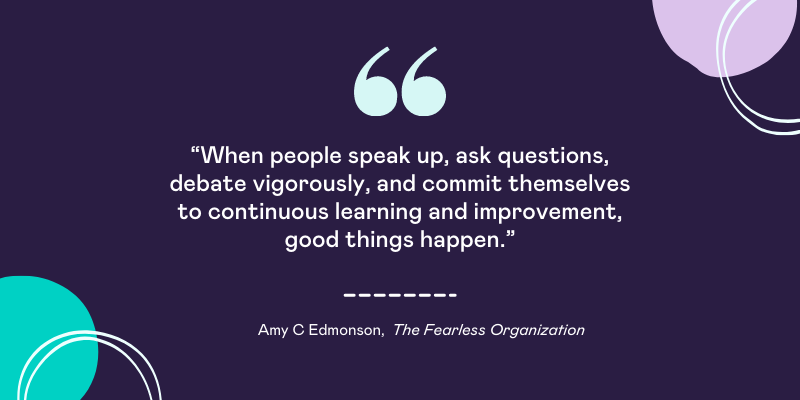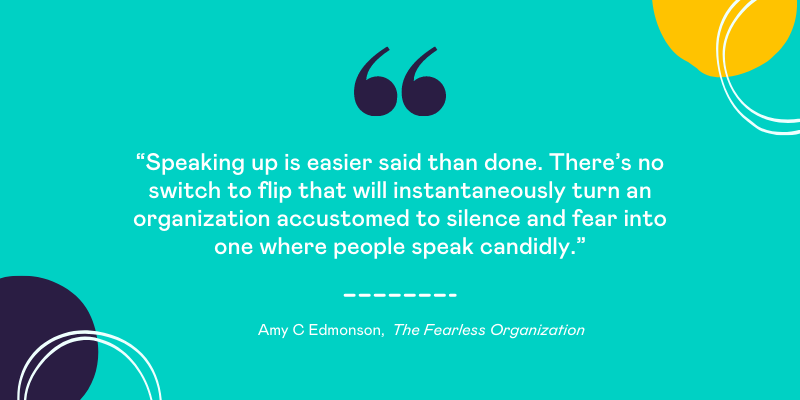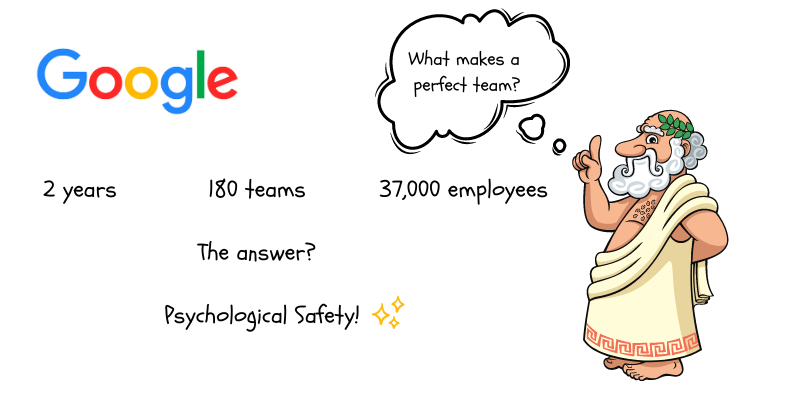While it takes many important elements to build a high-performing team, there’s one that is the cornerstone of them all and that’s building psychological safety.
This freedom to express opinions and offer feedback without the fear of reprisal is the single most essential thing to establish in your workplace if you want to build a thriving, resilient and high-performing team.
What is psychological safety?
Psychological safety describes a situation where a person feels calm and confident in their ability to express their opinions and feelings. It is a relatively new consideration when it comes to workplace safety, which has traditionally been more concerned with physical or mental wellbeing, but one that offers a huge amount of insight into building more resilient teams and individuals.
The phrase ‘team psychological safety’ was coined by Amy C. Edmondson, a professor at Harvard Business School who found a link between that safety, learning behaviour and team performance.
Establishing psychological safety isn’t a question of avoiding all distressing situations and ensuring that no one talks about negative things. Instead it is about building trust around communication and expression by showing that all feedback is welcome and that there is no punishment for sharing an opinion.

Why is psychological safety important for my organisation?
If you’re hoping to build a strong team and flourishing organisation, then psychological safety is very important. It is an environment that encourages a lot of the behaviour that is associated with high-performing teams: independence, honesty and reasonable risk taking.
Psychological safety can help improve the way teams interact and collaborate and can also help with employee engagement and retention, with Accenture reporting that workplaces with high psychological safety enjoy 76% more engagement and 50% more productivity.
How can leaders create psychological safety in high-performing teams?
There are plenty of things you can do to encourage an atmosphere of psychological safety in your organisation. Help your teams feel psychologically safe to perform to the highest of their abilities by:
Show your own vulnerability
One of the best ways to create feelings of psychological safety at work is to lead by example – and that means allowing yourself to be vulnerable in front of your team. By opening up about your own hopes and fears, you develop psychological safety and you make space for others to do the same.
The CIPD found that if you want to build psychological safety, it’s important for teams to feel they can speak up or take action without being embarrassed, rejected or punished.
Empathetic leaders who are curious, willing to ask questions and happy to share are well placed to help their teams expand their scope.
Demonstrate empathy and active Listening:
Show genuine concern for other team members’ well-being and actively listen to their concerns and ideas. Empathy creates a supportive and understanding team environment.
Invest in learning and experimentation
Set your teams up for growth by making it easy for them to access employee development opportunities. Whether through mentioning, coaching, formalised education or online courses, the ability to expand skill sets and improve talents not only helps improve psychological safety, but also tends to accelerate alongside it.
It’s also smart to allow space for practising those new skills and to experiment with new ideas. This encourages an innovate mindset and ensures there’s space to play.
Make room for mistakes
If you want people to be able to grow and innovate, you need to make it clear that there is room for experimentation – and that they won’t be reprimanded for making mistakes.
Mistakes happen; the important thing is how you come together to get over them. You may even be able to learn valuable lessons and you’ll definitely have more knowledge than you would in an environment where everyone feels as though they have to follow strict rules.
Promote collaboration over criticism
For a team that knows its own power and potential, be sure to put plenty of work into creating real collaboration – especially when things go wrong.
Yes, it’s good fun to share in successes, but it’s also very beneficial to avoid directing criticism at any one particular person or part of a team. Instead, invite collaboration on how you can all do better and make improvements for the future.
Communicate on a human level
Avoid creating distance or alienating your team with jargon or overly officious language and lean into communicating on a more human level. This means recognising the various personalities and preferences of your team members and treating each with respect.
Communicating as a leader means being able to inspire and reassure, especially if you want to be able to promote psychological safety and make space for improved performance.
Publicly recognise change
Show a team that their efforts are appreciated and that they will be rewarded, by making sure to recognise achievements and a willingness to change. This means celebrating behaviours as well as bottom lines.
For example, you might want to take to an employee communication platform to let everyone know how impressed you are by someone’s willingness to learn or their ability to share their skills.
Encourage open and honest feedback
Effective feedback is a cornerstone of psychological safety. To create psychological safety and encourage open and honest feedback, consider implementing the following practices:
- Create feedback channels: Establish multiple channels for team members to provide feedback, such as regular one-on-one meetings, team retros, or anonymous suggestion boxes. Different team members may feel more comfortable using different channels.
- Regular feedback sessions: Schedule regular feedback sessions to discuss team dynamics, communication, and areas for improvement. Emphasise that these sessions are a safe space for open discussions and that all feedback will be received constructively.
- Emphasise both positive and constructive feedback: Encourage team members to not only share areas that need improvement but also recognise and appreciate each other’s strengths and contributions. Celebrating successes boosts team morale and reinforces positive behaviour.
Ask your team how safe they feel
It doesn’t matter how hard you’re trying to create a space of psychological safety for your team, there’s a chance it might not be working and the only way to know for sure is to ask them.
It’s a good idea to use personal one-to-ones to open up a dialogue but beware that some team members may be wary of sharing every detail. An anonymous survey that asks the tough questions and offers space for suggestions can be a handy addition.

Measuring psychological safety
While psychological safety is subjective, there are several methods and tools that can provide valuable insights. Here are some effective ways to measure psychological safety:
Surveys and questionnaires:
Anonymous surveys and questionnaires are widely used to assess psychological safety within a team. These surveys typically contain carefully crafted questions to better understand team members’ perceptions of the company culture.
Sample questions may include:
- “Do you feel comfortable taking risks and sharing new ideas within the team?”
- “Do you believe your opinions are valued and respected by team members and leaders?”
- “Do you feel safe admitting mistakes or asking for help when needed?”
- “Do you feel that disagreements are handled constructively within the team?”
Using a Likert scale or open-ended responses, team members can rate their agreement with statements or provide more detailed feedback. The data collected from these surveys can help leaders identify patterns and trends related to psychological safety.
Behavioural observations:
In addition to surveys, leaders can keep an eye on certain behaviour to assess psychological safety. This involves actively observing team interactions during meetings, projects, and everyday interactions. Look for signs of open communication, trust-building behaviours, and the willingness of team members to take risks and share ideas.
Observations might involve noting:
- How often team members speak up and contribute during discussions
- The level of engagement and enthusiasm displayed during brainstorming sessions
- How team members respond to mistakes or challenges
- The presence of active listening and empathy in team interactions
By being attentive to these behaviours, leaders can gain a deeper understanding of the team’s dynamics and identify opportunities to strengthen psychological safety.
1-1 conversations:
Holding individual interviews or informal discussions with team members can provide valuable insights into their perceptions of psychological safety. These one-on-one conversations offer a safe and confidential space for team members to share their thoughts, concerns, and suggestions.
Leaders can inquire about topics such as:
- How team members feel about expressing their opinions in team settings
- Instances where team members felt supported or unsupported in the past
- Ideas for improving the team’s culture and communication dynamics
These conversations not only provide valuable feedback but also signal to team members that their input is genuinely valued.
Team performance and engagement metrics:
While not directly measuring psychological safety, team performance and engagement metrics can serve as indirect indicators of a psychologically safe environment. High-performing teams with high levels of engagement often have a strong foundation of psychological safety, as team members feel motivated and supported to contribute their best efforts.
Evaluate metrics such as:
- Team productivity and output
- Employee retention rates and job satisfaction surveys
- Innovation and creativity metrics
Positive trends in these metrics may indicate that the team’s psychological safety is contributing to overall success and satisfaction.

Case studies of high-performing teams with psychological safety
Google’s Project Aristotle:

Google, known for its data-driven approach, conducted a comprehensive study called Project Aristotle to measure psychological safety and understand what factors contribute to high-performing teams. The findings of this study revealed that psychological safety was the most critical factor for team success.
In Google’s high-performing teams, team members felt comfortable taking risks and expressing their thoughts and ideas without fear of negative consequences. They knew they could trust their teammates and that their contributions would be valued. As a result, these teams demonstrated higher levels of collaboration, creativity, and problem-solving abilities.
Google’s recognition of psychological safety’s impact led the company to implement several initiatives to foster this environment within its teams. Team-building exercises, regular team feedback sessions, and various leadership development workshops were introduced to strengthen trust and communication. By prioritising psychological safety, Google created a culture where innovation and productivity thrived, resulting in numerous successful projects and products.
Pixar’s Creative Team Culture:
Pixar, renowned for producing some of the most beloved animated films, attributes much of its success to a culture of psychological safety that fosters creativity and innovation.
In Pixar’s creative team meetings, open feedback and idea-sharing are not only encouraged but celebrated. Team members are invited to pitch their ideas without fear of judgment, and constructive criticism is offered in a positive and supportive manner. This collaborative approach has allowed Pixar to produce critically acclaimed and commercially successful films.
Key to Pixar’s success is also their emphasis on embracing failure as an integral part of the creative process. Team members are encouraged to take creative risks, knowing that not every idea will succeed. This culture of learning from failures and valuing diverse perspectives has nurtured a creative ecosystem that continuously produces groundbreaking storytelling and animation.
Zappos’ Customer-Centric Approach:
Zappos, an online shoe and clothing retailer, has built its reputation on providing exceptional customer service. At the heart of their customer-centric approach lies a psychologically safe environment that empowers employees to go above and beyond for their customers.
Zappos fosters a culture where employees are encouraged to take ownership of their interactions with customers. Employees are empowered to make decisions and resolve issues without the fear of reprimand if something goes wrong. This freedom to act creates an environment where employees feel trusted and valued, motivating them to provide the best possible customer experience.
In addition, Zappos encourages open communication and feedback within the organisation. Regular feedback loops between employees and managers ensure that concerns are addressed promptly, and improvements are continually made.
By creating a psychologically safe workplace environment that prioritises customer satisfaction, Zappos has cultivated a passionate and dedicated team that consistently delivers exceptional service. This has resulted in a loyal customer base and a strong brand reputation in the highly competitive e-commerce industry.
Transform your culture with Mo

- Improve employee engagement scores
- Reduce employee churn
- Build a collaborative culture
Mo is a new kind of reward and recognition platform that makes it easy for busy managers to meaningfully recognise, engage and connect with their teams.
We equip managers with weekly suggestions to energise and connect with their people, help teams build habits of recognition into their day-to-day rhythms and go beyond simple rewards as a way to motivate staff.
Join companies like SHL, OVO Energy and William Hill in delivering meaningful improvement on engagement results with Mo. Book a free demo today!




